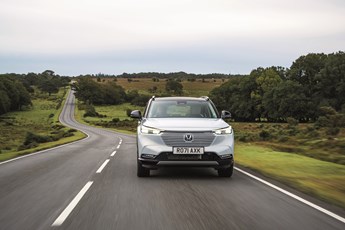
The start point for the best source of fleet information |
Model update: Honda HR-V Advance Style
Date: 31 March 2022 | Author: Sean Keywood

|
|
||||||||
Having dazzled the new car market in 2020 with its sci-fi electric E, Honda's big new car launch the following year covered more conventional ground, with the third-generation version of its HR-V. It's a compact SUV, rivalling cars such as the Ford Puma, although the HR-V is at the larger end of that segment, and in fact nudges close in length to C-segment cars such as the Nissan Qashqai (the latter less than 6cm longer). Having first tried the HR-V on the international launch last year, we've now had the chance to sample it on UK roads.
Looking over what seems like a relatively high bonnet line (although large door mirrors help with all-round visibility) the HR-V does feel like a large car - not unwieldy, but certainly without the nimbleness of something like a Puma, although drivers who are drawn to SUVs because they want more of a 'big car' feeling might appreciate this.
There's also none of the Ford's handling sharpness here. The HR-V feels woolly and pedestrian in corners and clearly doesn't appreciate being hustled. On a more positive note, the Honda's ride quality is good - rarer than you might think in this segment.
There's only one engine option with the HR-V - a conventional hybrid that pairs two electric motors with a 1.5-litre petrol engine for a combined output of 131hp. It's fine performance-wise, and the technical complexities of the different power sources are handled smoothly enough, but a droning engine note makes itself heard under even light acceleration, while tackling an uphill motorway on-ramp turns things positively cacophonous. Although, like with most hybrids, the HR-V will switch between electric-only, EV-and-engine-together, and engine-charges-the-battery modes according to which it judges most efficient at any particular time, it seems generally unwilling to spend much time in EV mode, regardless of battery state. Coasting on electric power alone is fine, but a light touch is needed on the accelerator not to engage the petrol engine, even at low speed when driving around town.
With the top-spec Advance Style equipment grade tested here, the HR-V's interior colour scheme, involving lots of cream (to our eyes anyway - the spec sheet calls it light grey) and also some copper detailing around the gear lever, might divide opinion, but we appreciate the added visual interest it provides. Materials are generally decent, though perhaps a few more scratchy plastic areas are present than with some rivals. On a more positive spec note, we found the heated seats and steering wheel particularly welcome on our January test drive.
On the infotainment front, the central touchscreen's graphics aren't the most modern, while in front of the driver, what looks at first glance like a fully digital dash actually features a physical speedometer, mounted next to a smaller screen, which includes an adjustable 'rev counter' area that is also capable of displaying other information such as satnav instructions. It works well enough, but isn't as visually impressive as rivals' full displays.
Although the HR-V is one of the largest cars in its class, that doesn't necessarily mean increased practicality. For one thing, although it is technically a five-seater, the middle section of the rear bench is narrow and raised significantly higher than the seats either side, meaning most adults would struggle to fit. On the plus side, there's lots of rear legroom, passengers in the 'proper' seats should be OK for headroom unless they are very tall, and Honda's 'Magic Seat' arrangement allows the squabs to be folded out of the way to accommodate tall luggage items in the rear of the cabin (the seats also fold flat in the conventional way). This augments a boot that at 320 litres with the Advance Style grade (335 litres otherwise) is fairly small - another disappointment given the HR-V's
overall size.
And there's more bad news for the Honda when we consider running costs. With its hybrid powertrain, you would expect it to have an advantage on fuel economy and emissions when compared with rivals such as the mild hybrid Puma, but in fact the Honda and Ford are very evenly matched in official WLTP testing. In addition, the also fully-hybrid version of the Renault Captur is a decent chunk more efficient still, while the HR-V is also expensive to buy compared with both those rivals.
Honda HR-V 1.5i-MMD Advance Style eCVT
P11D: £32,435
Residual value: 38.9%
Depreciation: £19,810
Fuel: £7,641
Service, maintenance and repair: £1,840
Cost per mile: 48.81p
Fuel consumption: 52.3mpg
CO2 (BIK %): 122g/km (28%)
BIK 20/40% a month: £147/£293
Luggage capacity: 320 litres
Engine size/power: 1,498cc/107hp plus 131hp electric motor
Verdict |
5/10 |
|||
 |
|
 |
|
|










